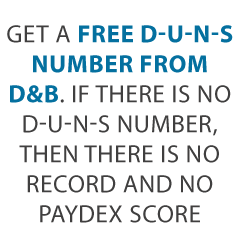- Connect With Us!
- (877) 600-2487
- info@creditsuite.com
Small Business Credit Building
Published By Janet Gershen-Siegel at March 2nd, 2018
Start Small Business Credit Building Today
Small business credit building can really work for you if you do it right. Fortunately, we know exactly how to establish small business credit.
Company credit is credit in a company’s name. It doesn’t attach to an owner’s individual credit, not even if the owner is a sole proprietor and the sole employee of the company.
Hence, a business owner’s business and individual credit scores can be very different. So here’s how to go about small business credit building.
Small Business Credit Building: The Advantages
Because business credit is independent from personal, it helps to secure an entrepreneur’s personal assets, in the event of a court action or business insolvency.
Also, with two distinct credit scores, a business owner can get two different cards from the same merchant. This effectively doubles purchasing power.
Another advantage is that even new ventures can do this. Visiting a bank for a business loan can be a formula for frustration. But building business credit, when done right, is a plan for success.
Personal credit scores depend on payments but also additional elements like credit utilization percentages.
But for small business credit, the scores actually merely depend on if a business pays its invoices timely.
Small Business Credit Building: The Process
Establishing company credit is a process, and it does not happen automatically. A business will need to actively work to establish company credit.
Nevertheless, it can be done readily and quickly, and it is much quicker than establishing individual credit scores.
Vendors are a big aspect of this process.
Accomplishing the steps out of order will cause repetitive denials. No one can start at the top with small business credit. For example, you can’t start with retail or cash credit from your bank. If you do, you’ll get a rejection 100% of the time.
Small Business Credit Building: Begin with Company Fundability
A small business must be fundable to credit issuers and vendors.
That is why a business will need a professional-looking website and email address. And it needs to have a website hosting bought from a merchant like GoDaddy.
Also, company telephone and fax numbers need to have a listing on ListYourself.net.
At the same time, the business phone number should be toll-free (800 exchange or the equivalent).
A small business will also need a bank account dedicated solely to it, and it needs to have every one of the licenses essential for running.
Licenses
These licenses all have to be in the specific, correct name of the business. And they need to have the same business address and phone numbers.
So note, that this means not just state licenses, but potentially also city licenses.
Learn more here and get started toward establishing company credit.
Small Business Credit Building: Get Started with Working with the IRS
Visit the Internal Revenue Service web site and acquire an EIN for the company. They’re totally free. Choose a business entity such as corporation, LLC, etc.
A small business can begin as a sole proprietor. But they will more than likely wish to change to a type of corporation or an LLC.
This is in order to reduce risk. And it will make best use of tax benefits.
A business entity will matter when it pertains to taxes and liability in case of a lawsuit. A sole proprietorship means the entrepreneur is it when it comes to liability and taxes. No one else is responsible.
Sole Proprietors Take Note
If you run a company as a sole proprietor, then at the very least be sure to file for a DBA. This is ‘doing business as’ status.
If you do not, then your personal name is the same as the company name. Because of this, you can find yourself being personally responsible for all small business financial obligations.
Additionally, according to the IRS, using this structure there is a 1 in 7 chance of an IRS audit. There is a 1 in 50 chance for corporations! Avoid confusion and significantly lower the odds of an IRS audit simultaneously.
Small Business Credit Building: Kicking Off the Process
Begin at the D&B website and get a totally free D-U-N-S number. A D-U-N-S number is how D&B gets a small business into their system, to produce a PAYDEX score. If there is no D-U-N-S number, then there is no record and no PAYDEX score.
Once in D&B’s system, search Equifax and Experian’s sites for the business. You can do this at fastcs.wpengine.com/reports. If there is a record with them, check it for correctness and completeness. If there are no records with them, go to the next step in the process.
By doing this, Experian and Equifax will have something to report on.
Vendor Credit Tier
First, you must build trade lines that report. This is also called the vendor credit tier. Then you’ll have an established credit profile, and you’ll get a business credit score.
And with an established business credit profile and score you can begin to obtain credit in the retail and cash credit tiers.
These varieties of accounts tend to be for the things bought all the time, like marketing materials, shipping boxes, outdoor work wear, ink and toner, and office furniture.
But first of all, what is trade credit? These trade lines are credit issuers who will give you preliminary credit when you have none now. Terms are oftentimes Net 30, instead of revolving.
So, if you get approval for $1,000 in vendor credit and use all of it, you must pay that money back in a set term, such as within 30 days on a Net 30 account.
Details
Net 30 accounts must be paid in full within 30 days. 60 accounts must be paid fully within 60 days. In comparison with revolving accounts, you have a set time when you must pay back what you borrowed or the credit you made use of.
To launch your business credit profile properly, you ought to get approval for vendor accounts that report to the business credit reporting agencies. When that’s done, you can then make use of the credit.
Then repay what you used, and the account is on report to Dun & Bradstreet, Experian, or Equifax.
Vendor Credit Tier – It Helps
Not every vendor can help in the same way true starter credit can. These are vendors that will grant an approval with minimal effort. You also need them to be reporting to one or more of the big three CRAs: Dun & Bradstreet, Equifax, and Experian.
You want 5 to 8 of these to move onto the next step, which is the retail credit tier. But you may have to apply more than once to these vendors. So, this is to confirm you are trustworthy and will pay timely. Here are some stellar choices from us: https://oldcs.creditsuite.com/blog/5-vendor-accounts-that-build-your-business-credit/
Retail Credit Tier
Once there are 5 to 8 or more vendor trade accounts reporting to at least one of the CRAs, then progress to the retail credit tier. These are service providers which include Office Depot and Staples.
Just use your Social Security Number and date of birth on these applications for verification purposes. For credit checks and guarantees, use the business’s EIN on these credit applications.
One such example is Lowe’s. They report to D&B, Equifax and Business Experian. They need to see a D-U-N-S and a PAYDEX score of 78 or better.
Fleet Credit Tier
Are there 8 to 10 accounts reporting? Then move to the fleet credit tier. These are service providers like BP and Conoco. Use this credit to purchase fuel, and to fix, and take care of vehicles. Just use your SSN and date of birth on these applications for verification purposes. For credit checks and guarantees, make certain to apply using the company’s EIN.
One such example is Shell. They report to D&B and Business Experian. They need to see a PAYDEX Score of 78 or better and a 411 company phone listing.
Shell might say they want a certain amount of time in business or revenue. But if you already have sufficient vendor accounts, that won’t be necessary. And you can still get approval.
Learn more here and get started toward establishing company credit.
Cash Credit Tier
Have you been responsibly managing the credit you’ve gotten up to this point? Then move onto the cash credit tier. These are businesses like Visa and MasterCard. Only use your SSN and date of birth on these applications for verification purposes. For credit checks and guarantees, use your EIN instead.
One example is the Fuelman MasterCard. They report to D&B and Equifax Business. They need to see a PAYDEX Score of 78 or higher. And they also want you to have 10 trade lines reporting on your D&B report.
Plus, they want to see a $10,000 high credit limit reporting on your D&B report (other account reporting).
Plus, they want you to have an established company.
These are businesses like Walmart and Dell, and also Home Depot, BP, and Racetrac. These are frequently MasterCard credit cards. If you have 14 trade accounts reporting, then these are in reach.
Learn more here and get started toward establishing company credit.
Small Business Credit Building: Monitor Your Business Credit
Know what is happening with your credit. Make certain it is being reported and attend to any inaccuracies as soon as possible. Get in the habit of taking a look at credit reports and digging into the specifics, and not just the scores.
We can help you monitor business credit at Experian and D&B for only $24/month. See: fastcs.wpengine.com/monitoring.
At Equifax, you can monitor your account at: www.equifax.com/business/business-credit-monitor-small-business. Equifax costs about $19.99.
Update Your Data
Update the details if there are mistakes or the relevant information is incomplete.
Small Business Credit Building: Fix Your Business Credit
So, what’s all this monitoring for? It’s to dispute any mistakes in your records. Mistakes in your credit report(s) can be fixed. But the CRAs often want you to dispute in a particular way.
Disputes
Disputing credit report mistakes usually means you send a paper letter with duplicates of any evidence of payment with it. These are documents like receipts and cancelled checks. Never mail the original copies. Always send copies and keep the originals.
Fixing credit report mistakes also means you specifically detail any charges you dispute. Make your dispute letter as crystal clear as possible. Be specific about the concerns with your report. Use certified mail so that you will have proof that you mailed in your dispute.
A Word about Small Business Credit Building
Always use credit smartly! Don’t borrow beyond what you can pay off. Track balances and deadlines for repayments. Paying off promptly and completely will do more to increase business credit scores than virtually anything else.
Growing small business credit pays off. Excellent business credit scores help a business get loans. Your loan provider knows the business can pay its financial obligations. They recognize the company is bona fide.
The business’s EIN attaches to high scores and loan providers won’t feel the need to call for a personal guarantee.
Small Business Credit Building: Takeaways
Business credit is an asset which can help your small business for many years to come. Learn more here and get started toward growing company credit.

 " class="attachment-blog-single size-blog-single wp-post-image" alt="Get Business Credit Cards for New Businesses Credit Suite-Business Line of Credit Decoded" title="Get Business Credit Cards for New Businesses">>
" class="attachment-blog-single size-blog-single wp-post-image" alt="Get Business Credit Cards for New Businesses Credit Suite-Business Line of Credit Decoded" title="Get Business Credit Cards for New Businesses">>